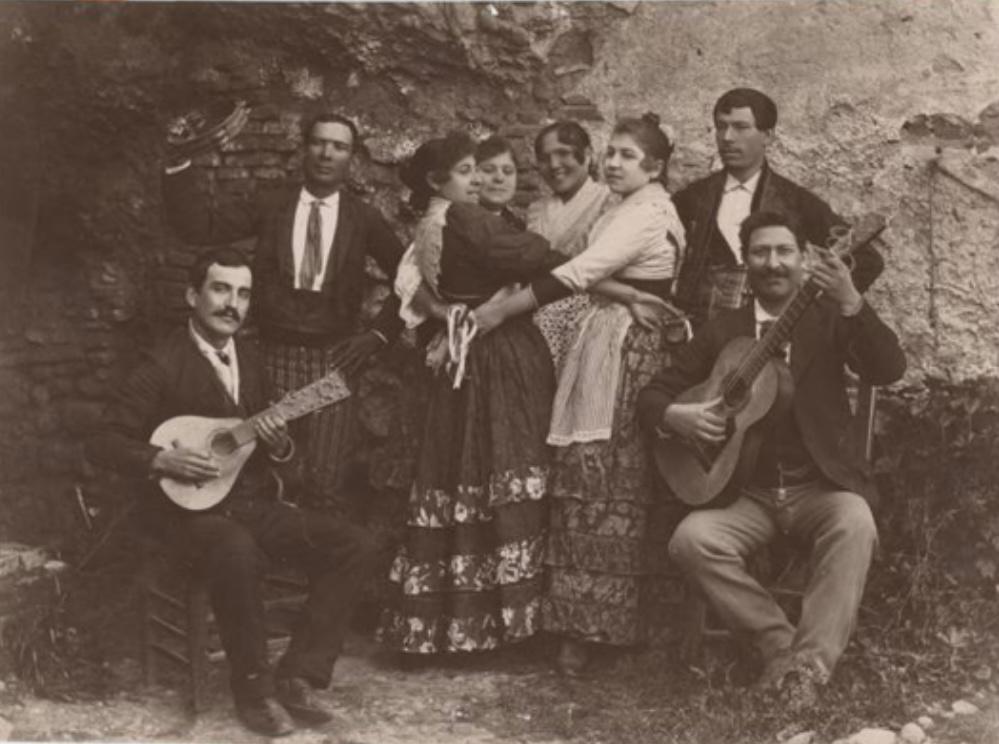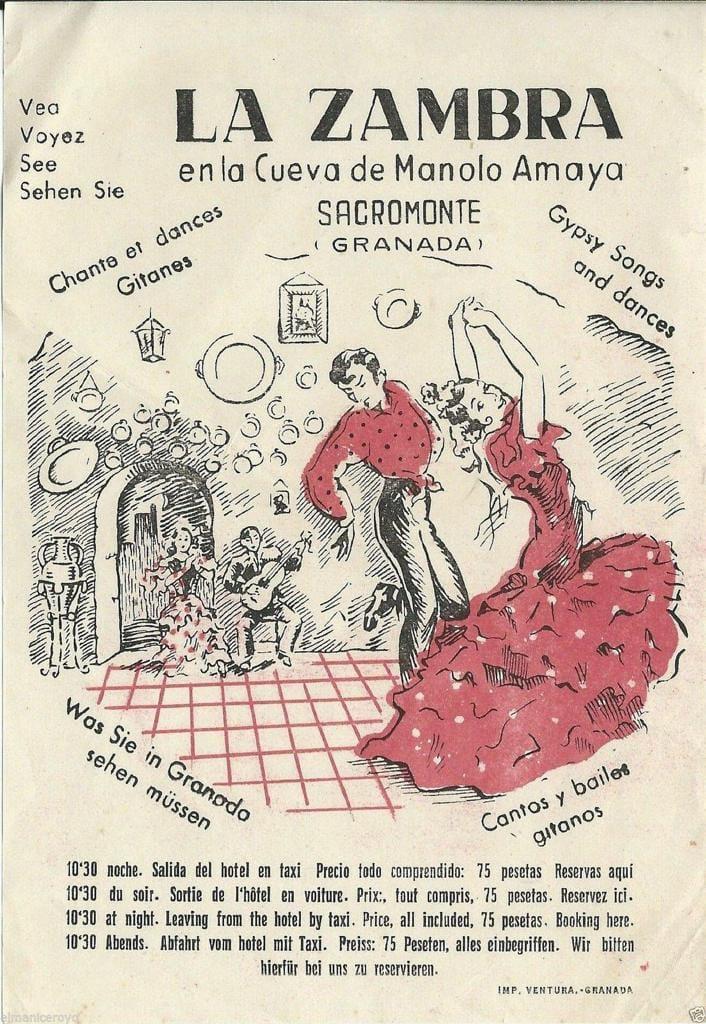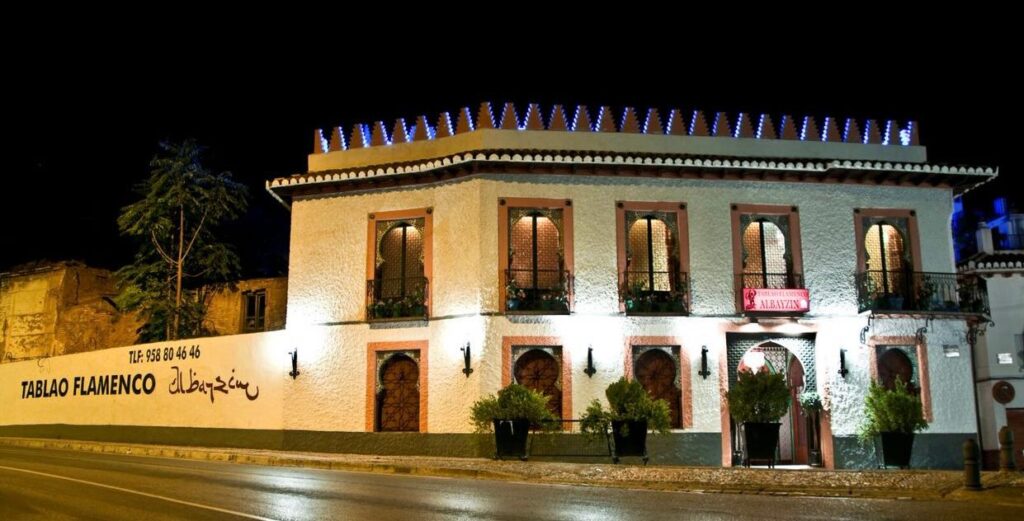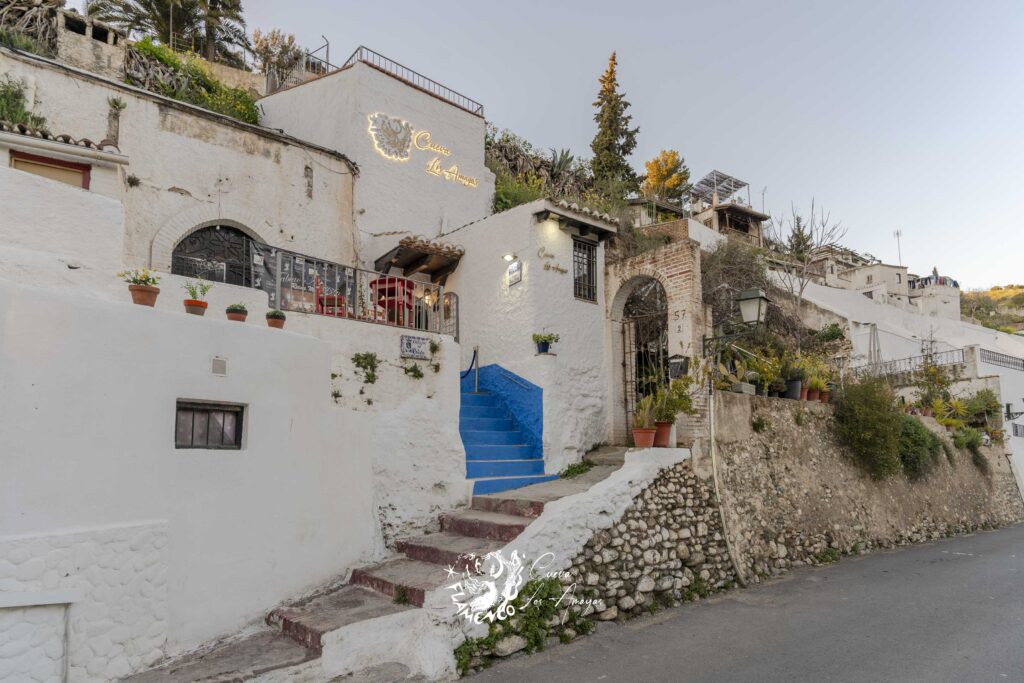The history of flamenco zambras in Granada is deep and rich, going back to the innovations of Antonio Torcuato “Cujón”, an outstanding gypsy from Itrabo. It was he who, in a blacksmith’s shop in the Plaza del Humilladero, conceived the idea of the first zambra. This precursor event gave way to the emblematic Zambra de los Amayas in Sacromonte, led by Captain Juan Amaya at the beginning of the 20th century.


Manuel Amaya Hidalgo, popularly known as “Manolo Amaya”, was a guitarist born in 1904 in Sacromonte, a neighborhood of Granada, where he also died in 1977. From an early age, he began playing in the zambra led by his parents, Juan Amaya and Dolores “la Capitana”. Manolo brought the tango of zambras to a wider audience, including American television, and was presented at the Barcelona International Exhibition in 1929, where he received a silver cup.
Throughout his life, Manolo collaborated with prominent flamenco figures such as Pepe Marchena, la Niña de los Peines, and Vallejo, and his influence spread to several continents, having performed in places such as Brazil and Buenos Aires since his youth. He also participated in important cultural events, such as the National Flamenco Singing Competition in Granada in 1922, organized by luminaries such as Manuel de Falla and Federico García Lorca. In addition, his zambra included renowned artists such as Carmen Amaya and her aunt “la Faraona”.
After his death, the void he leaves behind is palpable in Sacromonte, where personalities such as Los Habichuelas, Los Ovejillas, Juanillo el Gitano and María la Canastera highlight the loss of a man whose presence was as robust and vital as a cypress tree from Sacromonte. Always dressed in mourning, he carried within him the deep sense of his race and the vibrant history of his neighborhood.
In addition to his impact on music and dance, Manolo Amaya left his mark on cinema, participating in films such as “Forja de Almas” and “María de la O”, as well as in numerous documentaries and an extensive discography. He was also co-founder of the Brotherhood of the “Christ of the Gypsies” and his presence was deeply felt in the ceremonies and processions that marked the cultural life of Granada.
Manolo was part of an extended artistic and gypsy family, including his son Juan, who assisted him in the zambras, and other notable relatives in the world of flamenco. He acted in several films and documentaries, leaving a deep mark on flamenco art.
His death marked a significant blow to Sacromonte, considered the patriarch of the neighborhood’s zambras. Manolo was also one of the founders of the Brotherhood of the “Christ of the Gypsies”, and his legacy in flamenco culture and in the gypsy community of Granada is still celebrated. His death was deeply felt, and he was remembered as a pillar of flamenco dance and music in his beloved Sacromonte.

In 2001, Sensi Amaya, a direct descendant of the renowned Amaya family, undertook a significant initiative to preserve and enrich the business legacy of his lineage in Granada. He decided to take over the “Reina Mora”, one of the oldest and most respected tablaos in the city, located in the heart of the historic Albayzín neighborhood. With vision and respect for its cultural heritage, Sensi transformed the space and renamed it “Tablao Flamenco Albayzín”.
This transformation was not just a name change, but a complete revitalization of the establishment’s cultural offerings. Sensi introduced an innovative programme that included flamenco shows that stood out for both their authenticity and their artistic quality. The decision to modernize the tablao while staying true to flamenco’s traditional roots proved to be a perfect balance between preservation and innovation.
The “Tablao Flamenco Albayzín” quickly became a crucial meeting point for flamenco aficionados, attracting tourists and locals alike, who were looking to experience the true spirit of flamenco in an intimate and welcoming setting. The atmosphere of the tablao, with its décor reminiscent of the ancient zambras of Sacromonte, and its programming that often includes some of the most prominent contemporary flamenco artists, make each night a vibrant celebration of gypsy culture.
Through his efforts, Sensi Amaya has not only honored the family tradition, but has also contributed significantly to the enrichment of Granada cultural scene. The “Tablao Flamenco Albayzín” has established itself as a bastion of flamenco culture, ensuring that the legacy of the Amayas’ will continue to influence the art of flamenco both in Spain and around the world.

Expansion continued in 2017 when Sensi Amaya extended its vision by acquiring a 19th century mansion in Malaga, inaugurating “Tablao Los Amayas” as a tribute to the painter Pablo Picasso. This space became a meeting point for flamenco fans, offering an immersive and authentic experience.
The legacy of the Amayas received an exciting new chapter in 2024 when José and Manuel Amaya, direct descendants of this iconic flamenco family, decided to return to their roots in Sacromonte, the vibrant heart of Granada’s flamenco. With deep respect for their heritage, they reopened the historic Cueva de los Amayas, a legendary space that has witnessed countless memorable performances over the decades.
In this evocative setting, José and Manuel offer a flamenco experience in its purest and most authentic form. Breaking with the modern trend of using amplification and elaborate stages, they opted for a more traditional approach that focuses on the essence of flamenco. The absence of public address systems and artificial stages allows the natural sound of guitar, cante jondo and taps to resonate directly through the walls of the cave, creating an intensely personal and intimate atmosphere.
This choice underscores the unique intimacy and complicity of flamenco art, where the connection between the artists and the audience is felt with every note and every movement. At the Cueva de los Amayas, visitors don’t just watch a performance, they engage in a collective experience of shared emotion and art. This approach has rejuvenated the traditional zambra in Granada, attracting both flamenco fans and new viewers seeking a deeper connection with this cultural art.
José and Manuel, with their return and this new initiative, have not only revitalized a historic space, but have also reaffirmed their family’s commitment to the transmission and celebration of flamenco in its truest and most unadulterated form. With each show, the Cueva de los Amayas becomes a vibrant witness to the living history of flamenco, ensuring that the legacy of the Amayas’ continues to inspire future generations.

This rich history not only celebrates the Amaya family’s contribution to flamenco, but also invites flamenco enthusiasts to experience the magic of flamenco in its most authentic and traditional setting.

